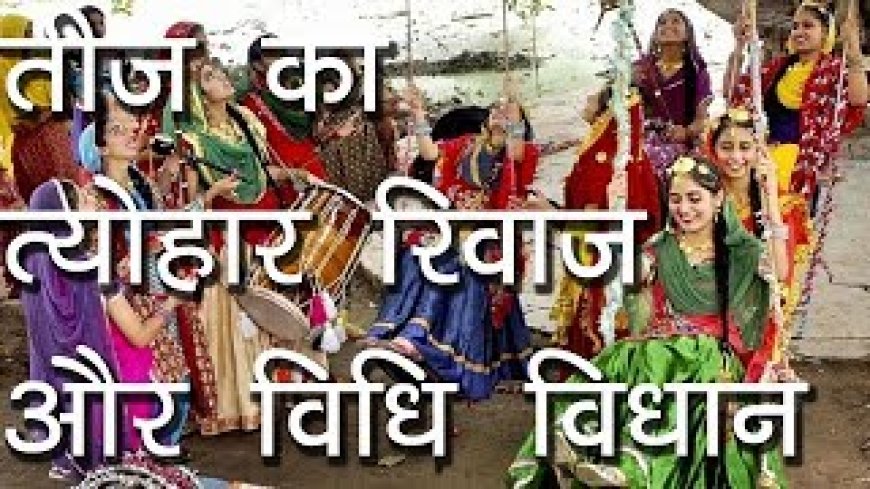Teej Festival

Teej Festival :
Teej is a traditional Hindu festival celebrated primarily by women in India. It is denoting the third day after the new Moon. It is dedicated to the goddess Parvati and is observed on various dates depending on the Hindu lunar calendar. There are three main types of Teej festivals: Hariyali Teej, Kajari Teej, and Hartalika Teej, each celebrated on different dates and with its own unique customs and traditions.
-
Hariyali Teej: Hariyali Teej, also known as Sawan Teej, usually falls in the month of Shravana (July-August). It marks the arrival of the monsoon season and the greenery it brings. Women, particularly married women, celebrate this day by fasting and praying for the well-being and longevity of their husbands. They dress in green attire, wear bangles, and apply mehndi (henna) on their hands. The day is spent singing traditional songs, dancing, and exchanging gifts.
-
Kajari Teej: Kajari Teej is celebrated in the month of Bhadrapada (August-September). This festival is especially significant for agricultural communities as it marks the beginning of the Kharif season when crops like rice and corn are sown. Women celebrate Kajari Teej by fasting, applying mehndi, and wearing colorful traditional clothing. They also sing folk songs related to farming and the monsoon season.
-
Hartalika Teej: Hartalika Teej is observed during the month of Bhadrapada as well, usually one day before Ganesh Chaturthi. This festival is associated with a legend involving the friendship and love between Parvati and Lord Shiva. On this day, women fast and recite prayers and stories from Hindu scriptures. They also create clay idols of the goddess Parvati and Lord Shiva, which are immersed in water after a specific period.
Why Teej celebrate :
Teej is primarily celebrated to honor and seek the blessings of the Hindu goddess Parvati, also known as Teej Mata, who is considered the epitome of marital bliss and devotion. The festival holds great significance for married women, and it is celebrated for several reasons:
-
Marital Bliss: Teej is a celebration of marital happiness and the strong bond between husband and wife. Married women fast and pray for the well-being and longevity of their husbands, seeking blessings for a prosperous and harmonious married life.
-
Devotion to Goddess Parvati: Teej is dedicated to the goddess Parvati, who is believed to have observed rigorous fasting and performed penance to win Lord Shiva's love and marry him. Women fast on this day to emulate her devotion and seek her blessings.
- Cultural Celebration: Teej is not only a religious festival but also a cultural celebration. It provides an opportunity for women to come together, dress in traditional attire, apply mehndi (henna), sing folk songs, and dance. It strengthens the sense of community and cultural identity.
How to celebrate Teej :
Celebrating Teej is a special occasion for Hindu women, particularly in India and Nepal. It involves various customs and traditions. Here's a general guide on how to celebrate Teej:
1. Fasting: Fasting is a significant part of Teej celebrations. Women fast from sunrise to moonrise, abstaining from food and drink during this period. Some women opt for a nirjala (without water) fast, while others may have simple foods like fruits, milk, and dry fruits.
2. Dress Traditionally: Women often wear traditional clothing, especially green-colored attire, as green is associated with Teej. They may also adorn themselves with traditional jewelry and apply mehndi (henna) on their hands and feet.
3. Worship the Goddess: Women gather at temples dedicated to the goddess Parvati (or another chosen deity) to offer their prayers. They perform rituals and sing bhajans (devotional songs) dedicated to the goddess.
4. Swing on Jhulas: Swinging on beautifully decorated swings or jhulas is a popular activity during Teej. Swings are often set up in courtyards or public areas, and women take turns swinging while singing traditional songs.
5. Apply Mehndi: Applying intricate mehndi designs on hands and feet is a tradition during Teej. Women often gather to apply mehndi on each other and have fun decorating their hands.
6. Exchange Gifts: Women exchange gifts and sweets with family members, friends, and in-laws as a sign of love and bonding. Giving and receiving gifts is a common practice to celebrate the occasion.
7. Sing and Dance: Women celebrate Teej by singing folk songs and dancing. These songs often revolve around themes of love, monsoon, and nature. Dancing together is a joyful part of the celebrations.
8. Traditional Sweets and Dishes: Special traditional sweets and dishes are prepared for Teej. These may include items like Thekua, Ghujia, Anarsa, malpua, jalebi, and various other regional delicacies.
What's Your Reaction?






















































